Sedimentary Evolution Laws and Main Controlling Factors of the Nenjiang Formation in the Songnan Da’anbei Area, China
Abstract
:1. Introduction
2. Geologic Setting
3. Sedimentary Characteristics of the Nenjiang Formation
3.1. Sedimentary Facies Markers
3.1.1. Rock Type
3.1.2. Sedimentary Structure
3.2. Types and Characteristics of Sedimentary Facies
3.2.1. Delta Plain
- (1)
- Distributary Channel
- (2)
- Crevasse Splay
- (3)
- Floodplain Deposits
3.2.2. Delta Front
- (1)
- Underwater distributary channels
- (2)
- River Mouth Bars
- (3)
- Sheet-like Sands
- (4)
- Interdistributary Bays
3.2.3. Lake Facies
- (1)
- Littoral Shallow Lake Deposits
- (2)
- Semi-deep Lake Deposits
4. Stratigraphic Division
4.1. Identification of Stratigraphic Interfaces
- (1)
- Sequence Boundary from Base-level Fall to Rise
- Scouring and erosion: Gravel at the base of river channel scour surfaces;
- Cyclical changes in sand-to-shale ratios: Below the interface, the grain size coarsens and the sand-to-shale ratio increases; above the interface, the grain size becomes finer and the sand-to-shale ratio decreases;
- Log signature: Electrical property discontinuities, with log curve patterns changing from regressive to transgressive sequence sets;
- Well–seismic calibration: Sequence boundaries generally correspond to troughs or the zero phase (Figure 6);
- Seismic reflection characteristics: Moderate-to-high continuity and moderate-to-weak amplitude seismic reflections, with the Nenjiang Formation, from bottom to top, corresponding to seismic reflectors T1, T07, T06, T04, T03′, and T03 (Figure 6).
- (2)
- Sequence Boundary from Base-level Rise to Fall (Lake Flooding Surface)
- Dark and varicolored mudstone segments;
- Facies change points;
- Locations of aggradational stacking pattern transitions;
- Log curve transitions from positive to negative cycles.
4.2. Stratigraphic Division and Characteristics
4.3. Stratigraphic Framework
5. Distribution of Sedimentary Facies
6. Sedimentary Evolution Control Factors
6.1. Control of Lake Level Changes on Sedimentary Systems
6.2. Control of Provenance Supply on Sand Body Distribution
6.3. Control of Paleoclimate on Sedimentary Evolution
7. Sedimentary Evolution Models
8. Conclusions
- (1)
- In the southern part of the Songliao Basin, Da’anbei area, the Nenjiang Formation primarily exhibits two types of sedimentary facies: shallow-water delta and lake. These can be further divided into four subfacies and nine microfacies. Chronologically, the Nen I segment predominantly features littoral shallow lake deposits and the Nen II segment mainly develops semi-deep lake deposits. As the lake level continuously declined, starting from the Nen III segment, delta front deposits began to develop and gradually took a dominant position, eventually transitioning to delta plain deposits by the Nen V segment.
- (2)
- Based on core observations, drilling, and analysis of planar sedimentary facies evolution and sand body development characteristics, two sedimentary models for the shallow-water delta of the southern Nenjiang Group have been established. In a deeper water context, the channel-river mouth bar sequence forms the progradational depositional sequence of the delta front framework. In a shallower water context, the channel-sheet sand sequence forms the delta front framework and gradually transitions to a progradational depositional sequence, moving into delta plain deposits.
- (3)
- The development of the shallow-water delta sedimentary system in the Nenjiang Formation of the study area is primarily influenced by relative lake level, provenance, and paleoclimate. Changes in climatic conditions, the continuous decline of the lake level, and the persistent supply from the northeastern provenance are the main factors contributing to the development of the progradational shallow-water delta in the study area.
Author Contributions
Funding
Institutional Review Board Statement
Informed Consent Statement
Data Availability Statement
Conflicts of Interest
References
- Shen, A.J.; Wang, Y.Q.; Lu, J.M.; Geng, Z.X.; Ru, G.R. Exploration theory and practice of lithological stratigraphic oil and gas reservoirs in the southern Songliao Basin. China Pet. Explor. 2004, 9, 40–44+71,72. [Google Scholar]
- Xiu, L.J.; Li, G.X.; Jian, O.; Weiwei, W. Distribution Law and Exploration Potential of Low-resistivity Reservoirs in the South of Songliao Basin. China Pet. Explor. 2006, 11, 7. [Google Scholar]
- Wang, H.W. Exploration practice of lithological oil reservoirs in the Heidi Temple oil layer of Changling Depression. Spec. Oil Gas Reserv. 2015, 22, 59. [Google Scholar]
- Postma, G. An analysis of the variation in delta architecture. Terra Nova 1990, 2, 124–130. [Google Scholar] [CrossRef]
- Reynolds, A.D. Variability in fluvially-dominated, fine-grained, shallow-water deltas. Sedimentology 2022, 69, 2779–2813. [Google Scholar] [CrossRef]
- Wang, M.Q.; Xie, J.; Zhang, Q.; Wang, Y.J.; Duan, Y.J. Characteristics and sedimentary model of a reticular shallow-water delta with distributary channels: Lower member of the Neogene Minghuazhen Formation in the Bozhong area of the Huanghekou Sag, China. Arab. J. Geosci. 2019, 12, 760. [Google Scholar] [CrossRef]
- Huang, X.; Liu, K.; Zou, C.; Yuan, X.; Gui, L. Forward stratigraphic modelling of the shallow-water delta system in the Poyang Lake, southern China. J. Geochem. Explor. 2014, 144, 74–83. [Google Scholar] [CrossRef]
- Liu, Z.; Shen, F.; Zhu, X.; Li, F.; Tan, M. Formation conditions and sedimentary characteristics of a Triassic shallow water braided delta in the Yanchang Formation, Southwest Ordos Basin, China. PLoS ONE 2015, 10, e0119704. [Google Scholar] [CrossRef] [PubMed]
- Geleynse, N.; Storms, J.E.; Walstra DJ, R.; Jagers, H.A.; Wang, Z.B.; Stive, M.J. Controls on river delta formation; insights from numerical modelling. Earth Planet. Sci. Lett. 2011, 302, 217–226. [Google Scholar] [CrossRef]
- Chen, C.; Zhu, Y.; Lei, Z.; Li, S.; Jiang, Y. Flume experiment study of the formation process and sedimentary characteristics of a shallow-water delta. Geol. J. 2023, 58, 837–848. [Google Scholar] [CrossRef]
- García-García, F.; Corbí, H.; Soria, J.M.; Viseras, C. Architecture analysis of a river flood-dominated delta during an overall sea-level rise (early Pliocene, SE Spain). Sediment. Geol. 2011, 237, 102–113. [Google Scholar] [CrossRef]
- Hao, S.; Liu, H.; Du, X.; Niu, C. Sedimentary characteristics of shallow-water delta and responses features in palaeoenvironment: A case study from the lower part of Neogene Minghuazhen Formation (Bonan area, Bohai Bay Basin, E China). Arab. J. Geosci. 2021, 14, 1–20. [Google Scholar] [CrossRef]
- Tian, L.X.; Liu, H.; Niu, C.M.; Du, X.F.; Yang, B.; Lan, X.D.; Chen, D.L. Development characteristics and controlling factor analysis of the Neogene Minghuazhen Formation shallow water delta in Huanghekou area, Bohai offshore basin. J. Palaeogeogr. 2019, 8, 1–19. [Google Scholar] [CrossRef]
- Cai, Q.S.; Hu, M.Y.; Liu, Y.N.; Kane, O.I.; Deng, Q.J.; Hu, Z.G.; Li, H.; Ngia, N.R. Sedimentary characteristics and implications for hydrocarbon exploration in a retrograding shallow-water delta: An example from the fourth member of the Cretaceous Quantou Formation in the Sanzhao depression, Songliao Basin, NE China. Pet. Sci. 2022, 19, 929–948. [Google Scholar] [CrossRef]
- Zhang, Y.; Bao, Z.; Dou, L.; Jiang, L.; Wei, M.; Zhang, L. Hydrodynamics and deposition in lacustrine shallow-water delta front: A combination of numerical simulations and modern sedimentation measurements. Interpretation 2020, 8, SM39–SM52. [Google Scholar] [CrossRef]
- Xu, Z.H.; Wu, S.H.; Liu, Z.; Zhao, J.S.; Geng, H.L.; Wu, J.C.; Zhang, T.Y.; Liu, Z.W. Sandbody architecture of the bar finger within shoal water delta front: Insights from the lower member of Minghuazhen Formation, Neogene, Bohai BZ25 oilfield, Bohai Bay Basin, East China. Pet. Explor. Dev. 2019, 46, 335–346. [Google Scholar] [CrossRef]
- Zhu, X.; Zeng, H.; Li, S.; Dong, Y.; Zhu, S.; Zhao, D.; Huang, W. Sedimentary characteristics and seismic geomorphologic responses of a shallow-water delta in the Qingshankou Formation from the Songliao Basin, China. Mar. Pet. Geol. 2017, 79, 131–148. [Google Scholar] [CrossRef]
- Xu, Z.H.; Plink-Björklund, P.; Wu, S.H.; Liu, Z.; Feng, W.J.; Zhang, K.; Yang, Z.; Zhong, Y. Sinuous bar fingers of digitate shallow-water deltas: Insights into their formative processes and deposits from integrating morphological and sedimentological studies with mathematical modelling. Sedimentology 2022, 69, 724–749. [Google Scholar] [CrossRef]
- Li, J.P.; Liu, H.; Niu, C.M.; Guo, R.B.; Wang, Y. Evolution regularity of the Neogene shallow water delta in the Laibei area Bohai Bay Basin, northern China. J. Palaeogeogr. 2014, 3, 257–269. [Google Scholar]
- Tong, Q.; Jiao, T.; Qi, Z.; Wang, H.; Liu, Y.; Zhu, Y.; Liu, H. Spatiotemporal evolution of single sandbodies controlled by allocyclicity and autocyclicity in the shallow-water braided river delta front of an open lacustrine basin. Open Geosci. 2021, 13, 98–121. [Google Scholar] [CrossRef]
- Zhang, X.; Wu, D.; Fu, M.; Deng, H.; Xu, Z.; Chen, C. Controls of sandstone architecture on hydrocarbon accumulation in a shallow-water delta from the Jurassic Shaximiao Formation of the western Sichuan Basin in China. Energy Rep. 2022, 8, 6068–6085. [Google Scholar] [CrossRef]
- Olariu, C.; Bhattacharya, J.P. Terminal distributary channels and delta front architecture of river-dominated delta systems. J. Sediment. Res. 2006, 76, 212–233. [Google Scholar] [CrossRef]
- Gani, M.R.; Bhattacharya, J.P. Basic building blocks and process variability of a Cretaceous delta: Internal facies architecture reveals a more dynamic interaction of river, wave, and tidal processes than is indicated by external shape. J. Sediment. Res. 2007, 77, 284–302. [Google Scholar] [CrossRef]
- Zhang, C.M.; Yin, T.J.; Zhu, Y.J.; Ke, L.M. Shallow water delta sedimentary model. J. Sedimentol. 2010, 5, 933–944. [Google Scholar]
- Li, S.M.; Song, X.M.; Liu, Y.Q.; Wang, Y.Q.; Li, Y.M.; Tang, H.J. Sedimentary models of Wenmi retreat type and progradation type shallow water braided river delta. J. Jilin Univ. (Earth Sci. Ed.) 2011, 3, 665–672. [Google Scholar]
- Zhu, Y.J.; Zhang, C.M.; Yin, T.J. Sedimentary characteristics and simulation of stacked shallow water delta. Geol. Sci. Technol. Inf. 2013, 3, 59–65. [Google Scholar]
- Yin, T.J.; Zhang, C.M.; Zhu, Y.J.; Yang, W.; Ye, J.G.; Cai, W.; Dai, Y.Y. Overlapping delta - a special type of shallow water delta. J. Geol. 2014, 2, 263–272. [Google Scholar]
- Liu, Z.L.; Shen, F.; Zhu, X.M.; Liao, J.J.; Zhang, X.Q.; Meng, H. Progress in shallow water delta research and case analysis of terrestrial lake basins. Geol. Oil Gas 2015, 36, 596–604. [Google Scholar]
- Qi, Y.; Wang, Y.; Qin, G.; Song, Y.; Zhang, H.; Meng, F. Sedimentary evolutionary processes, architecture, and sedimentary model of a lobate shallow-water delta: Insights from flume simulation experiments. Front. Earth Sci. 2024, 12, 1393211. [Google Scholar] [CrossRef]
- Wu, S.H.; Xu, Z.H.; Liu, Z. Sedimentary configuration of river controlled shallow water delta. J. Paleogeography 2019, 2, 202–215. [Google Scholar]
- Zhang, P.; Qian, Q.H.; Jiang, M.Z.; Chen, X.Q.; Wang, A.M.; Chai, X.; Song, Z.Y.; Feng, W.J. Sedimentary characteristics and sedimentary models of shallow water deltas on the edge of arid lake basins: Taking the VI oil formation of the Lower Oil Sand Mountain Formation in the Gaskule Oilfield, Qinghai Province as an example. J. Sedimentol. 2023, 41, 839–854. [Google Scholar]
- Ren, D.W.; Wei, S.Y.; Yin, T.J.; Chen, S.W.; Fang, J.S.; Zhao, W.K. Response process of finger shaped sand bar type shallow water delta sedimentation under the background of lake level changes: Based on flume sedimentation simulation experiments. Modern Geol. 2024. [Google Scholar] [CrossRef]
- Zhang, L.; Bao, Z.D.; Lin, Y.B.; Chen, Y.M.; Lin, X.H.; Dou, L.X.; Kong, B. Genetic types and sedimentary model of sandbodies in a shallow-water delta: A case study of the first Member of Cretaceous Yaojia Formation in Qian’an area, south of Songliao Basin, NE China. Pet. Explor. Dev. 2017, 44, 770–779. [Google Scholar] [CrossRef]
- Li, M.; Chen, B.; Ruan, J.F.; Bao, Z.D.; Zeng, D.S.; Zheng, J.H.; Xiao, H.Z.; Shi, J.M. Spatial Development Characteristics of Shallow Water Delta Skeleton Single Sand Body in Quansi Member of Lower Cretaceous in Xinmin Oilfield, Songliao Basin. Marine Geol. Quat. Geol. 2019, 39, 46–55. [Google Scholar]
- Fu, C.; Yu, X.H.; Li, S.L.; Li, S.L.; Gao, M.X.; Peng, Z.X.; Zhao, H.Q. Response of lacustrine sequence styles and delta morphology under the background of differential accommodation space: A comparative study of Poyang Lake and Daihai Lake. J. Paleogeography 2022, 24, 1084–1098. [Google Scholar]
- Li, J.; Shu, L.S. Structural characteristics and evolution of the Mesozoic and Cenozoic in the Songliao Basin. J. Nanjing Univ. (Nat. Sci. Ed.) 2002, 38, 525–531. [Google Scholar]
- Liu, Z.J.; Wang, D.P.; Liu, L.; Liu, W.Z.; Wang, P.J.; Du, X.D.; Yang, G. Sedimentary characteristics of the Cretaceous period in the Songliao Basin. J. Geol. 1992, 6, 327–338. [Google Scholar]
- Yuan, X.J.; Zhou, H.Y.; Zhang, Z.J.; Wang, Z.Y.; Cheng, D.W.; Guo, H.; Zhang, Y.Y.; Dong, W.T. Sedimentary characteristics and growth patterns of large shallow water deltas in depressed lake basins. Lithol. Oil Gas Reserv. 2021, 33, 1–11+281. [Google Scholar]
- Mo, W.L.; Wu, C.D.; Zhang, S. Formation mechanism of large delta front deposits in the continental depression lake basin of the second and third members of the Nenjiang Formation in the Songliao Basin. J. Pet. Nat. Gas 2012, 34, 1–6+164. [Google Scholar]
- Sun, Z.X.; Zhang, Y.N.; Liu, C.L.; Li, M.G. Sedimentary characteristics of shallow water deltas and their significance for oil and gas exploration. J. Pet. Nat. Gas 2012, 34, 161–165+3. [Google Scholar]
- Yang, H.; Hu, M.Y.; Cai, M.; Wang, D.; Cai, Q.S. Sedimentary characteristics and development models of the Nen 3 and 4 progradational shallow water delta in the Daqingzijing area of the southern Songliao Basin. Daqing Pet. Geol. Dev. 2022, 41, 1–10. [Google Scholar]
- Cross, T.A. Controls on Coal Distribution in Transgressive-Regressive Cycles, Upper Cretaceous, Western Interior, USA. Spec. Publ. Soc. Econ. Paleont. Miner. 1988, 42, 371–380. [Google Scholar]
- Wang, S.M.; Liu, Z.J. Analysis and application of changes in baseline and tolerable space. World Geol. 2001, 20, 1–7. [Google Scholar]
- Zhu, X.M.; Liu, Y.; Fang, Q.; Li, Y.; Liu, Y.Y.; Wang, R.; Song, J.; Liu, S.Q.; Cao, H.T.; Liu, X.N. Formation conditions and sedimentary models of shallow water deltas in large depression lake basins: Taking the Fuyu oil layer in the Sanzhao depression of the Songliao Basin as an example. Front. Geosci. 2012, 19, 89–99. [Google Scholar]
- Hubert, J.F. A Zircon-Tourmaline-Rutile Maturity Index and the Interdependence of the Composition of Heavy Mineral Assemblages with the Gross Composition and Texture of Sandstones. J. Sediment. Res. 1962, 32, 440–450. [Google Scholar]
- Yang, R.C.; Li, J.B.; Fan, A.P.; Zong, M.; Zhang, T. Research progress and development trends in source analysis of terrestrial sedimentary rocks. Pet. Geol. Exp. 2013, 31, 99–107. [Google Scholar]
- Zhang, S. Debate on the Late Cretaceous “Marine Invasion” Event in the Songliao Basin and Suggestions for Solution. Daqing Pet. Geol. Dev. 2021, 40, 1–12. [Google Scholar]
- Tian, M.; Zhang, M.S.; Ren, Y.G.; Qiao, X.Y.; Wan, C.B.; Liu, P.J. Spore pollen algae assemblages and their environment in the third section of the Nenjiang Formation in the Xinzhan area of the Songliao Basin. J. Jilin Univ. (Earth Sci. Ed.) 2005, 35, 449–455. [Google Scholar]
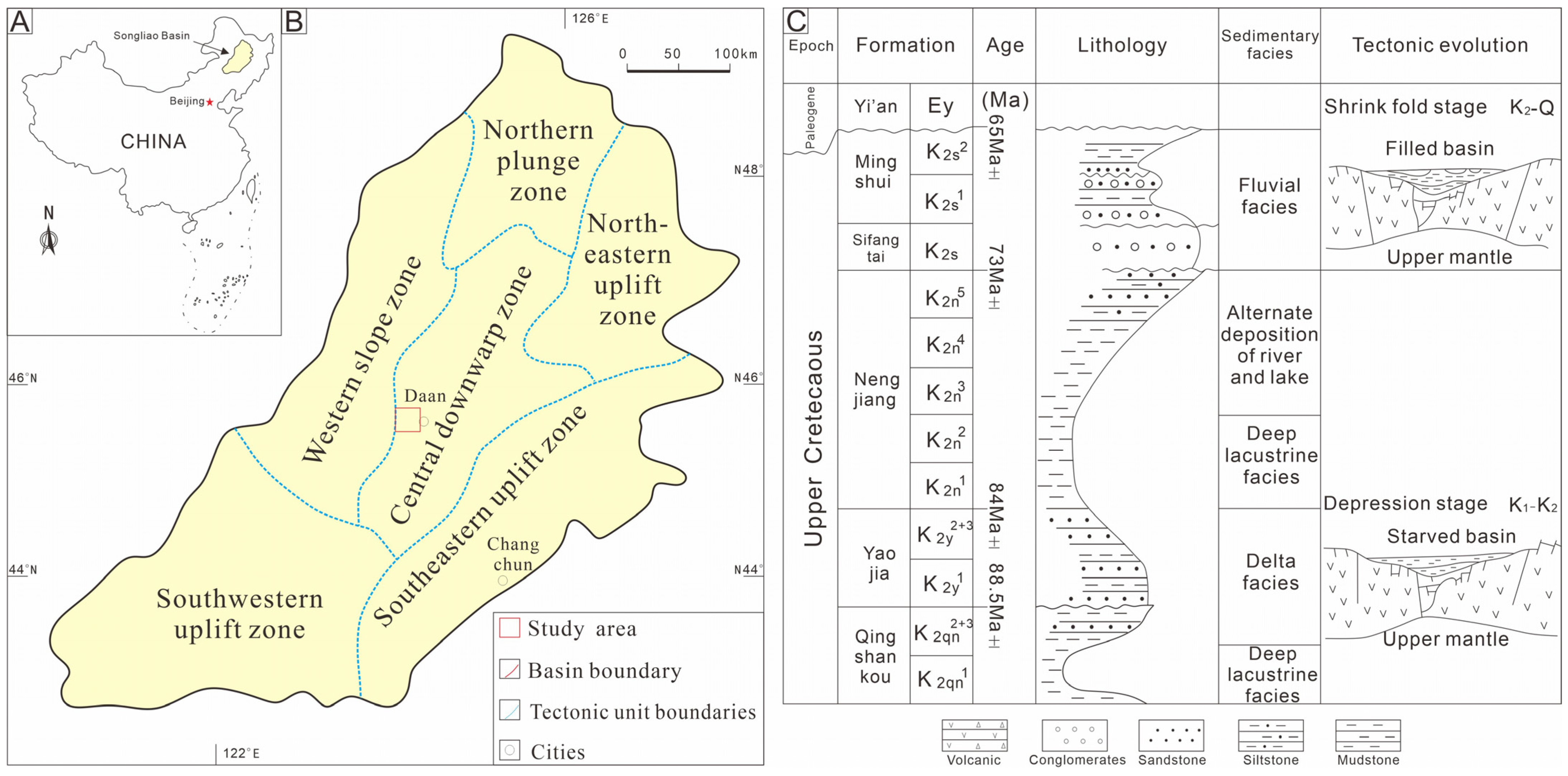


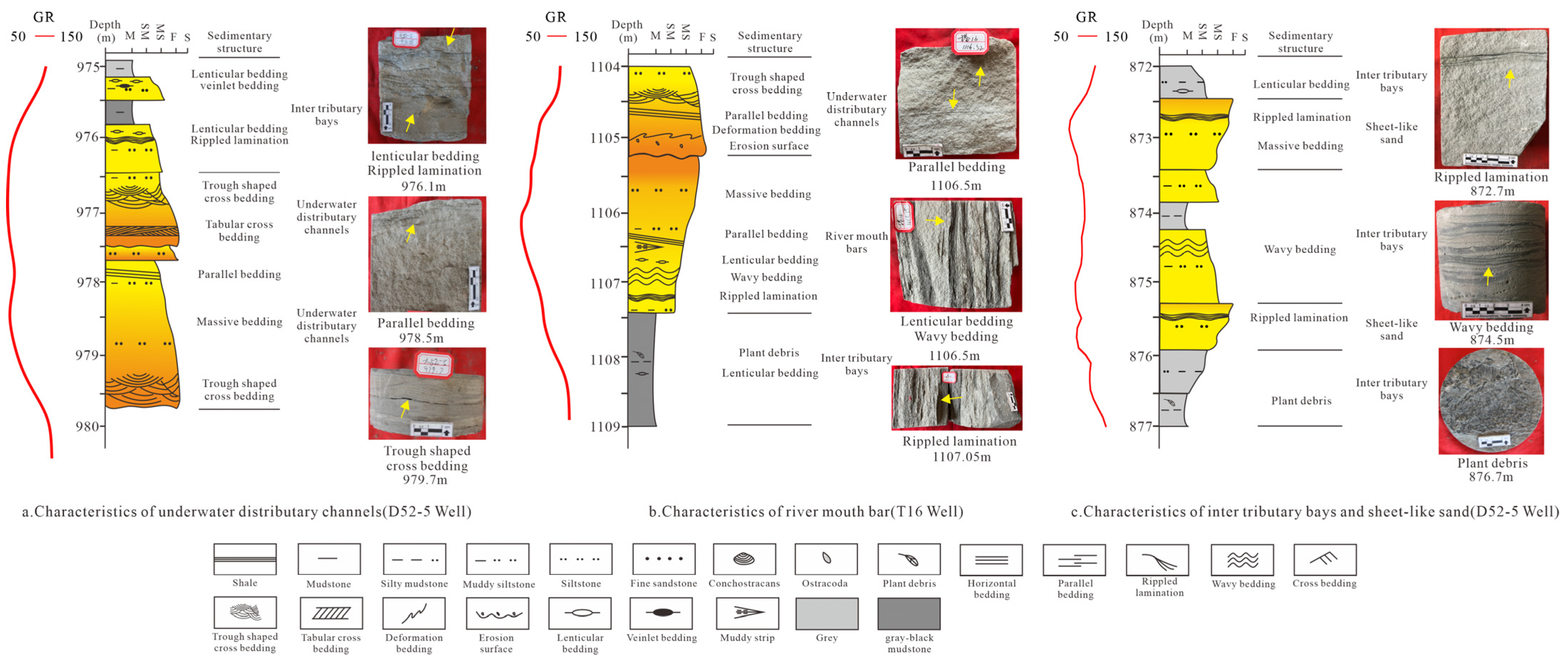
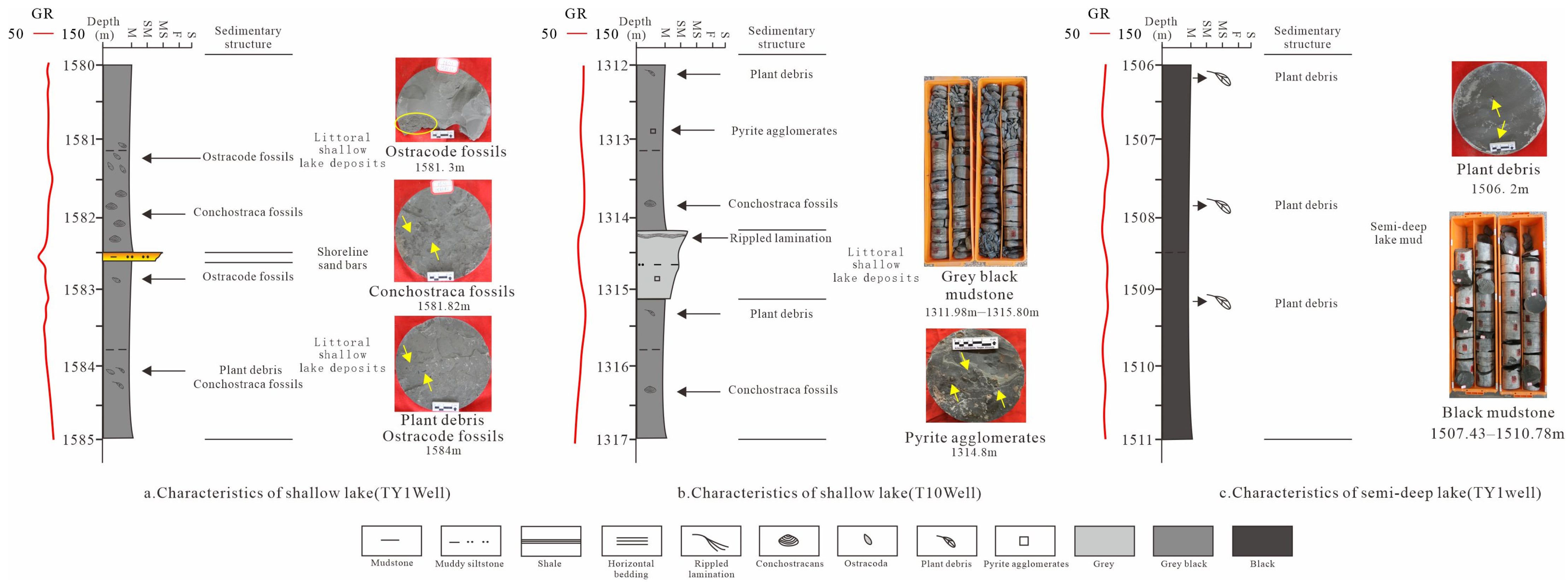

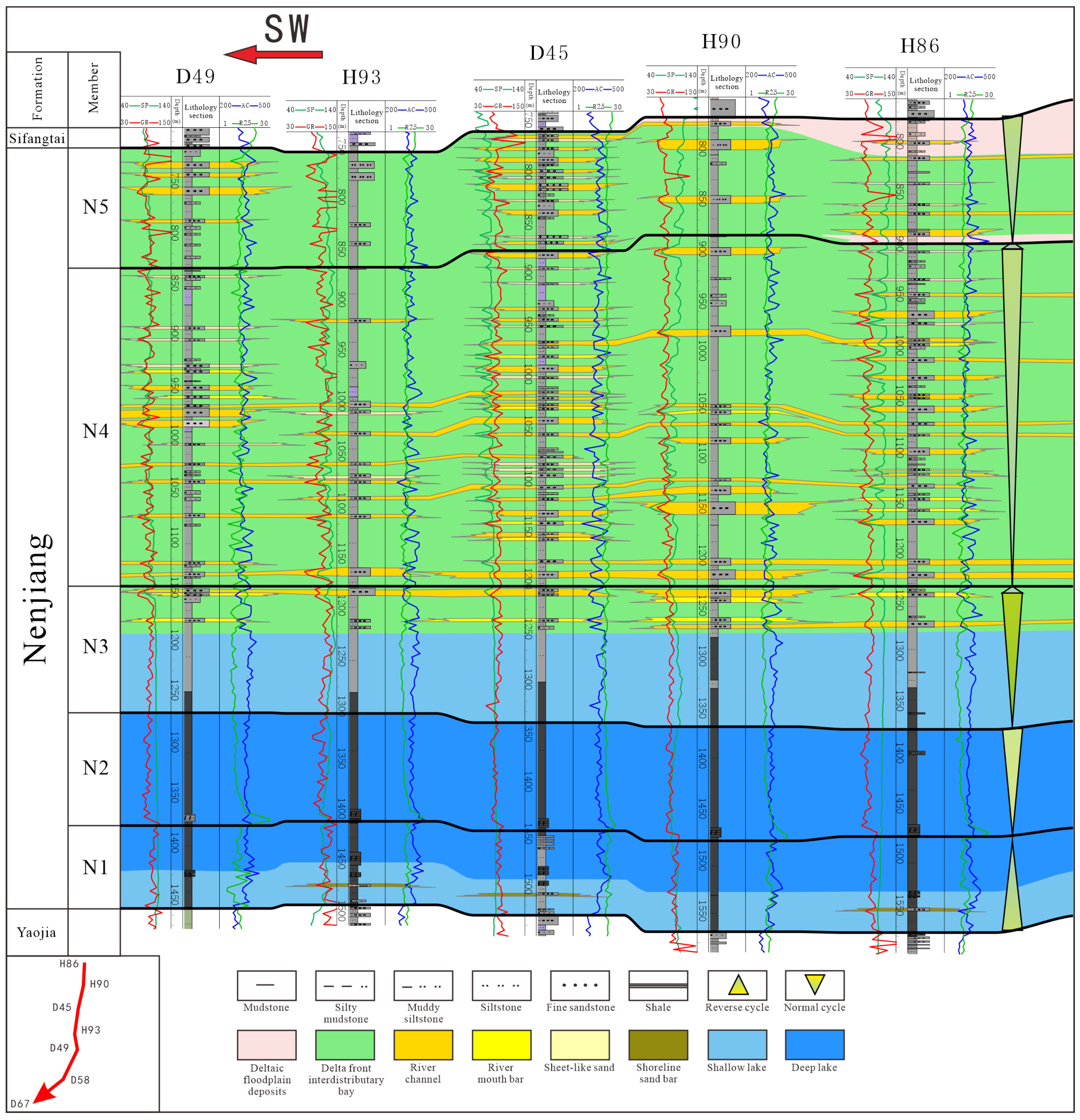


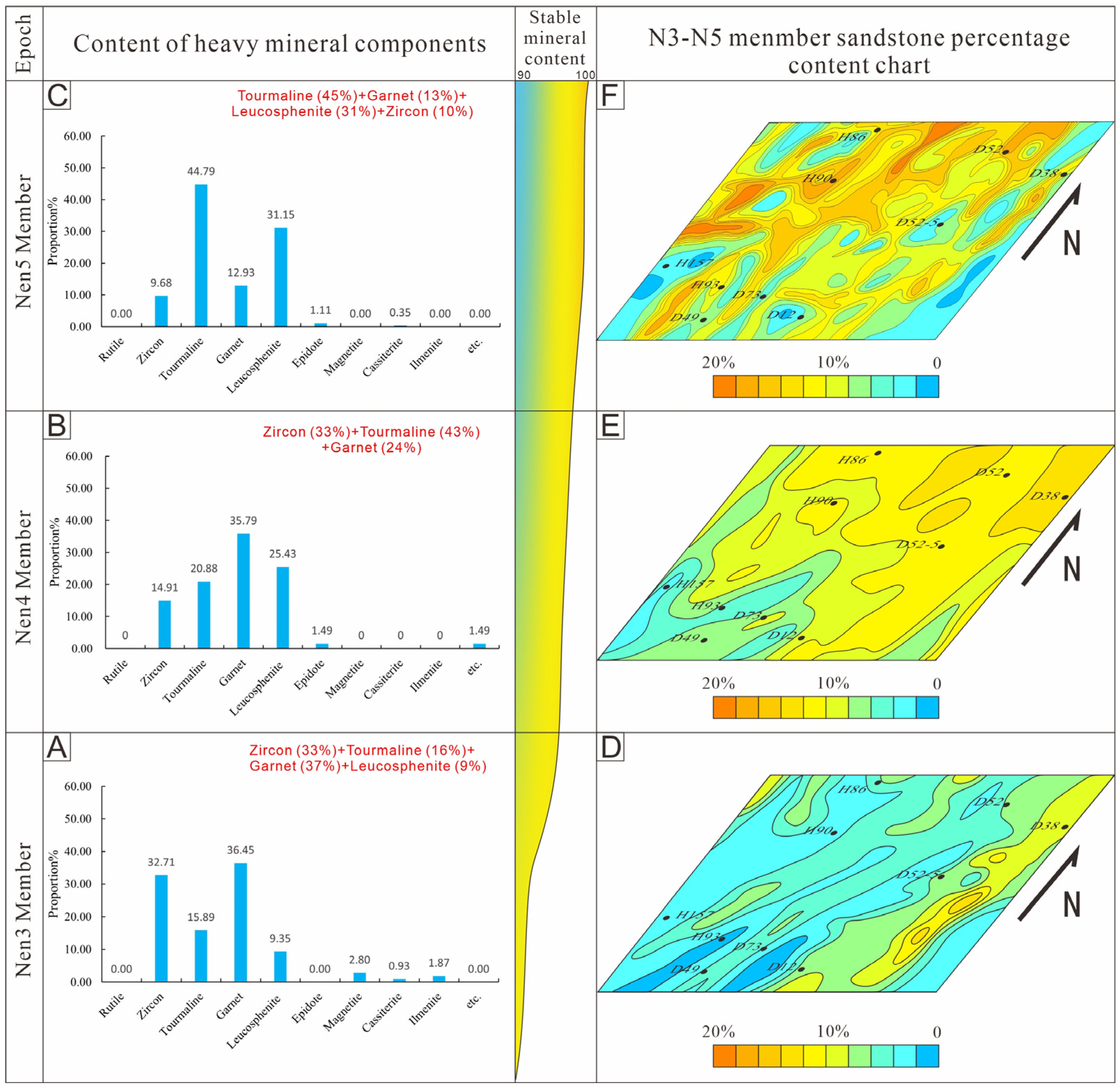
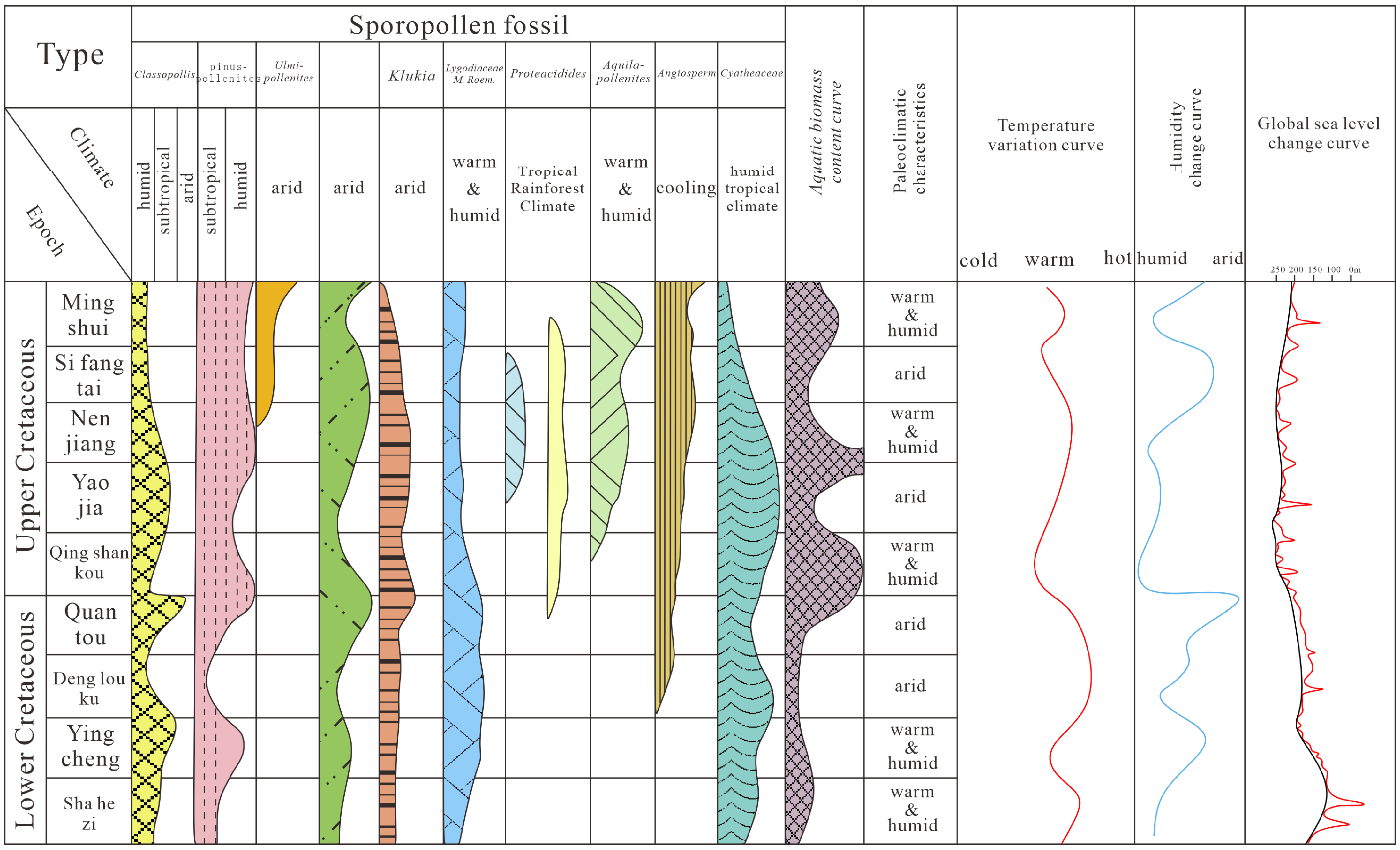
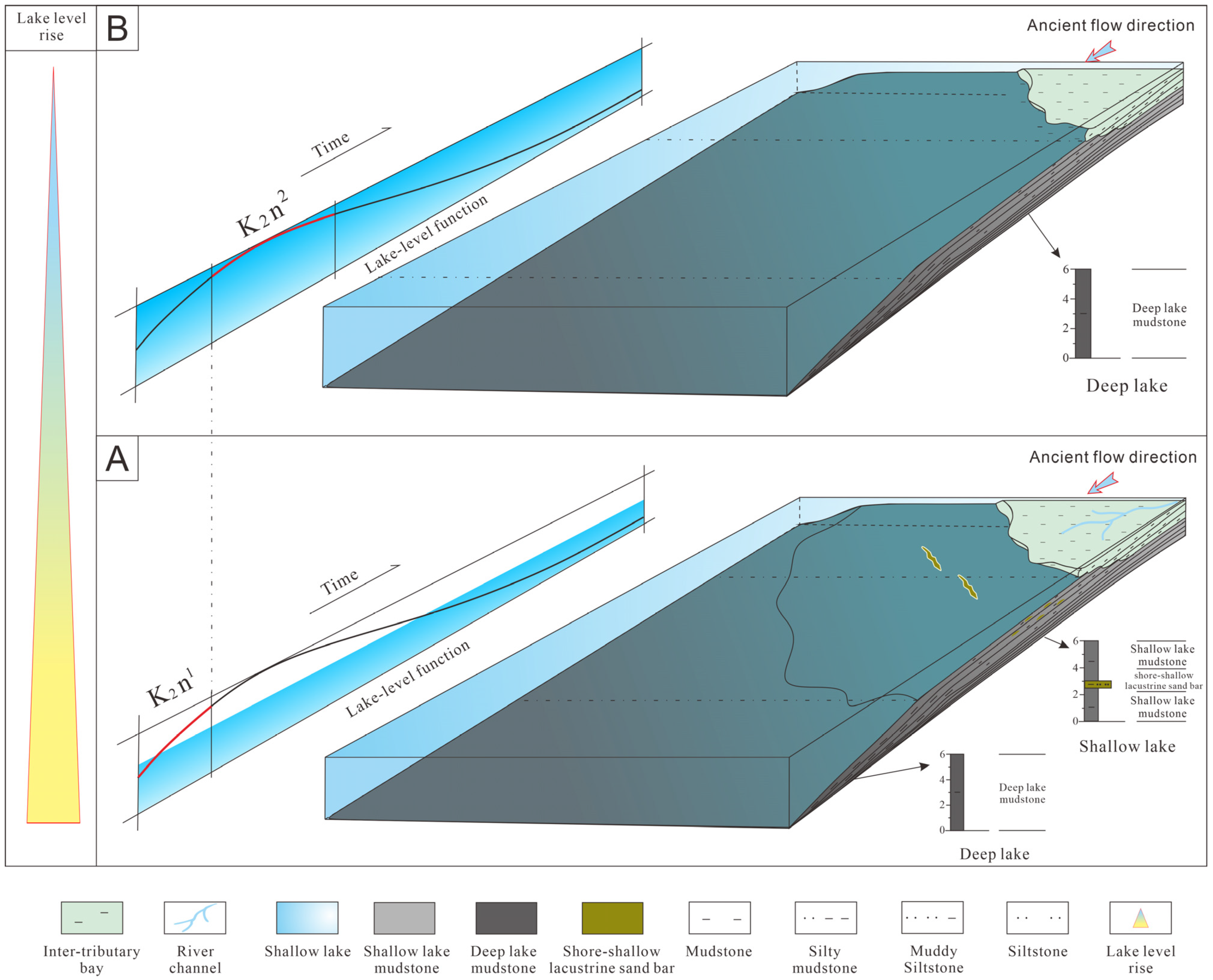
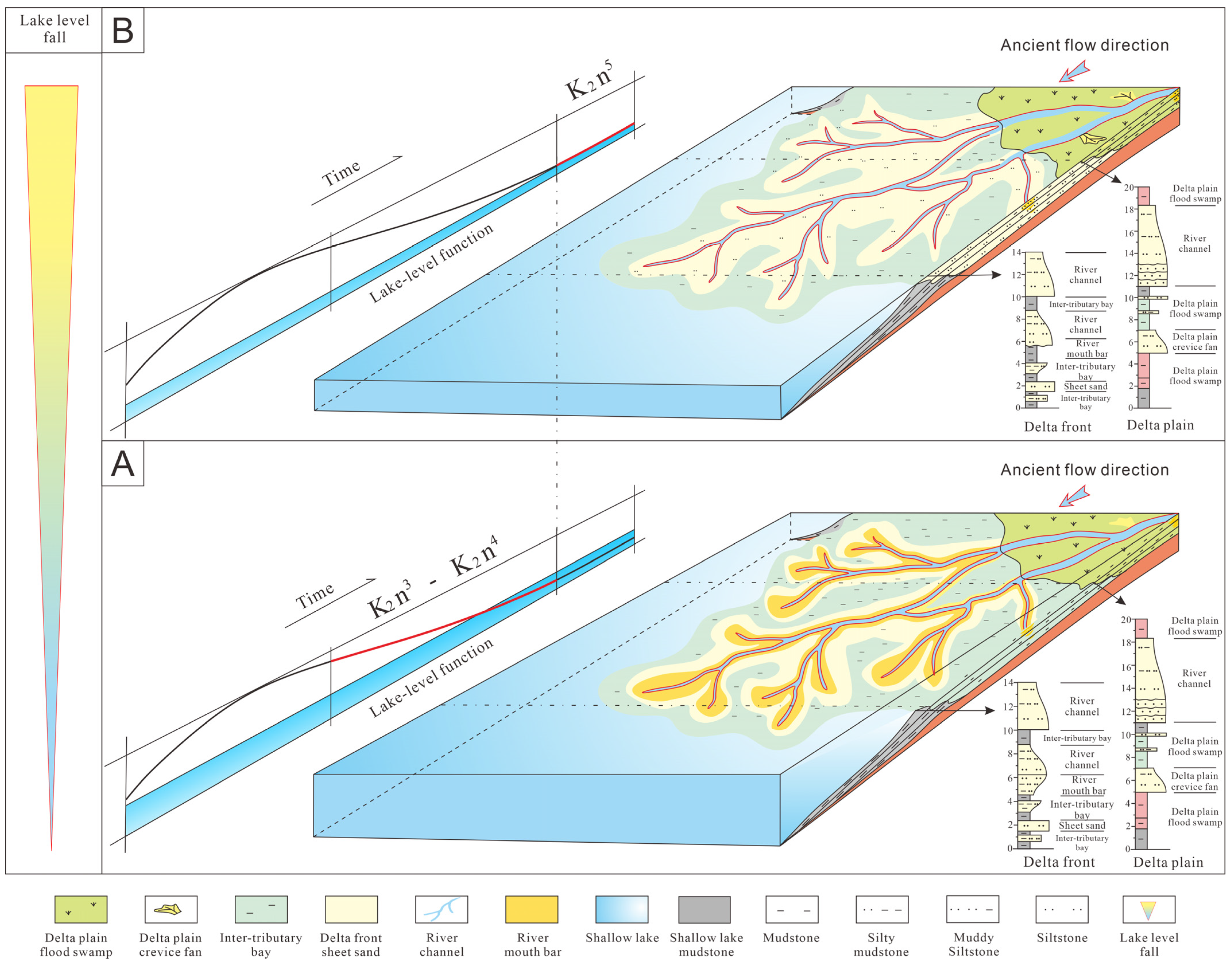
Disclaimer/Publisher’s Note: The statements, opinions and data contained in all publications are solely those of the individual author(s) and contributor(s) and not of MDPI and/or the editor(s). MDPI and/or the editor(s) disclaim responsibility for any injury to people or property resulting from any ideas, methods, instructions or products referred to in the content. |
© 2024 by the authors. Licensee MDPI, Basel, Switzerland. This article is an open access article distributed under the terms and conditions of the Creative Commons Attribution (CC BY) license (https://creativecommons.org/licenses/by/4.0/).
Share and Cite
Yuan, L.; Hu, M.; Deng, Q. Sedimentary Evolution Laws and Main Controlling Factors of the Nenjiang Formation in the Songnan Da’anbei Area, China. Appl. Sci. 2024, 14, 5269. https://doi.org/10.3390/app14125269
Yuan L, Hu M, Deng Q. Sedimentary Evolution Laws and Main Controlling Factors of the Nenjiang Formation in the Songnan Da’anbei Area, China. Applied Sciences. 2024; 14(12):5269. https://doi.org/10.3390/app14125269
Chicago/Turabian StyleYuan, Lei, Mingyi Hu, and Qingjie Deng. 2024. "Sedimentary Evolution Laws and Main Controlling Factors of the Nenjiang Formation in the Songnan Da’anbei Area, China" Applied Sciences 14, no. 12: 5269. https://doi.org/10.3390/app14125269



